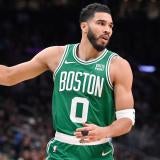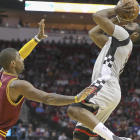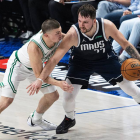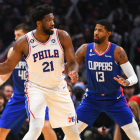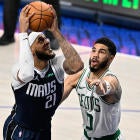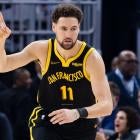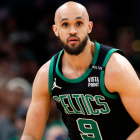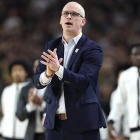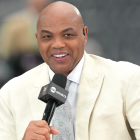A good way to determine if the NBA has an actual problem with game play is when casual fans start to complain. The League Pass faithful will always have quibbles, but when folks who are only really invested in marquee matchups or the playoffs think something is off, that's an issue the league has to resolve.
Last year, when querying any casual fan watching, you heard a complaint: "Why do those guys get free throws just for chucking it up from behind the 3-point line when a guy comes near them?"
The issue became widespread last season because it's a difficult situation in the first place to officiate. Most tricks that players use, officials get better at. Head snaps, fake falls, arm grabs, the officials in the NBA have seen them all. But for some reason, this trick, used most prominently by Houston Rockets guard James Harden, grinds almost everyone's gears. Even coaches whose players use the "trick" routinely, don't love it, but they acknowledge its usefulness.
The NBA, however, listened to the complaints, and this summer issued new guidelines for officials when it comes to these fouls drawn on 3-point shots.
Short version: If a player has not yet gathered the ball when contact occurs, it’s a common foul, not a shooting foul.
— Howard Beck (@HowardBeck) September 21, 2017
Also, if refs determine that offensive player lunged into defender, or locked his arm to create contact, they could assess offensive foul
— Howard Beck (@HowardBeck) September 21, 2017
The key, as NBA officials put it, is "sequencing." If contact comes before player starts shooting motion, it's a common foul. No free throws
— Howard Beck (@HowardBeck) September 21, 2017
The fact that it's called "The Harden Rule" is telling, and the next logical question is what exactly this means for the Beard himself, who finished second in MVP voting last season. Harden's reputation is drawn along two parallel lines, depending on what part of his game stands out to you, the fan. He's either a brilliant scorer and playmaker who is always able to create any shot he wants, with efficiency, and one of the smoothest and most tactically precise playmakers in the game ... or he's a habitual flop artist who flops at will.
There's a psychological bias called the Zeigarnik Effect, where it's been observed that humans remember and recall incidents prior to an interruption or stoppage more clearly than others in a sequence. So, naturally, when there's a stoppage in play of a basketball game due to a foul call, if that event is repeated time and time again, it's going to build up a well of cognitive bias in evaluating Harden's play.
But just what is the effect of this rule going to be on Harden's game this season, and what does that mean for Houston?
THE TRICK
The key change the league has instituted this season (per the NBA's points of emphasis video) is that the foul is now different on jump shots vs. drives or moving shots. Per the NBA:
"For jump shots, the shooting motion starts when the offensive player starts to bring the ball upward toward the basket." Think of this like the NFL rule for fumbles vs. incomplete passes from quarterbacks. If the player has started to bring the ball up, it's a shooting foul. Otherwise, it's a common foul. Watch this one from last season:
Here's a close-up version. You can see Harden gathers the ball prior to the foul, but the question is whether he's bringing the ball up to shoot:
Harden has gathered the ball, before the contact is made, but he hasn't started to bring the ball up.
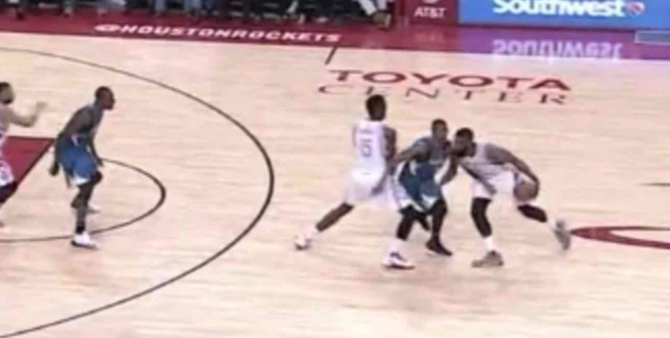
So under the new rules, if the officials are quick enough to catch it, that should be a common foul and not a shooting foul.
What makes some of this so difficult is the fact that it's in the pick and roll. Even veteran, experienced, quality defenders get caught reaching on Harden. The temptation is always there to try and corral his dribble. But especially when you're trying to squeeze in-between a screen that's pushing you out, it gets difficult. Harden's a master at recognizing the defender coming over the top and leaning back into the screen to reduce the room the defender has, effectively sandwiching him.
The problem for the officials will be that Harden is an expert at anticipating the foul, and starting to bring the ball up into the foul before it happens.
Even when you slow this down, you see that Harden's going into this motion before Wilson Chandler's arm gets there. Knowing that a foul is coming and going into your shot motion, if you're not initiating the contact by leaning, it shouldn't be a foul. The response is that Harden's not "really trying" to get a shot off. But Harden doesn't have to take a good shot for it to be a foul (or else Nick Young would have never been fouled, ever).
Here, Harden's moving the ball up before Matt Barnes even sticks his hand up:
And the same problem exists on drives. Harden's insanely adept at recognizing when players are reaching, and bringing his arm up on layups. If he were standing still, it would be similar to the "rip-through" move, which was legislated as a common foul a few years ago but continues to be called a shooting foul.
For moving shots, the gather is the important part, not bringing the ball up. Harden has clearly already gathered here, so it's still a shooting foul.
The issue of an offensive player "trapping" the opponent's hand being an offensive foul is really interesting. If you're trying to understand what that means, watch Stephen Curry's left hand here:
Harden not only moves his right arm up for the shooting motion, but he catches Curry's, trapping it into a foul. It's worse on drives where opponents try and reach in to pluck the ball away from behind. Try that, and half the time, Harden snatches that arm against his side and drags the defender like a trailer behind him.
What does all this tell us?
Harden's still going to draw fouls and get to the line when opponents reach. The Spurs, as ESPN's Tom Haberstroh profiled on this issue, knew how to combat this in their semifinals matchup against Houston, by constantly keeping their hands up. But Harden's dribble puts guys to sleep and there's a reason time after time their hands are in the cookie jar. Still, the number of these fouls Harden racks up will decrease. So what's the impact going to be?
THE NUMBERS
First off, it's important to note how many points Harden created off free throws last year. In the pick and roll alone, via Synergy Sports, Harden drew 63 shooting fouls off dribble jumpers, which was 24 percent of the time he took those kinds of shots, leading the league in that very specific category. Harden led the league in free throws last season, and he does create them in a variety of ways. He's always going to get to the line.
To get a sense of how rule changes can impact him, though, take a look at his transition numbers.
In 2015, when Harden was also runner-up to MVP Curry, Harden drew shooting fouls in transition 20.3 percent of the time. In 2016 that number shrunk to 15.9 percent, and last season, despite being one of the two most productive offensive players in the league, his transition shooting fouls dipped again, this time to just nine 9.3 percent of the time.
Not only that, but Harden's individual offensive numbers plummeted:
James Harden in transition | Points Per Possession | % of possessions resulting in free throws | % of possessions resulting in shooting fouls |
| 1.122 | 22.9 | 20.3 |
2015-16 | 1.073 | 18.5 | 15.9 |
2016-17 | 0.926 | 11.3 | 9.3 |
What changed? Well, for starters, Mike D'Antoni came in and Harden's transition passing numbers exploded. Harden went from 162 transition assists in 2015 to 234 last season, a 72-assist leap. The other notable thing is that Harden's penchant for bowling into defenders in transition started to be watched more closely. Here's a play from 2015 where he drew a foul:
Here's a remarkably similar play in 2017:
Now, Harden adjusts; it's what he does. But there are things that can stifle him, and this rule figures to be one.
There's no way to accurately predict what kind of numbers impact this specific rule will have on Harden since we don't know if he'll still try and create those same shots, or if the rule will be consistently called differently. But Harden created 97 shooting fouls on jump shots out of the pick and roll last year. Even if there's just a 30 percent reduction in that figure, before factoring in the penalty, that's 58 fewer points just out of that specific instance. Tack on similarly different calls in isolation, or on drives off the pick and roll, and you have numbers that start to rack up. Haberstroh noted Harden drew 122 fouls off 3-pointers alone last season. While not all of those fouls would fall under the Harden role, he generated an insane amount of offense from those plays.
It won't devastate Harden, he's too versatile, too good. But it will require adjustments. He's got more help with Chris Paul this year, he won't have to rely on those tricks as much. It is something to watch, though, not only for Harden, but for the other players who drew a lot of fouls in those situations last year.
Jeff Teague (25.7 percent shooting foul ratio), Goran Dragic (16.6 percent) and Lou Williams (20.9 percent) are just three of the players who will likely suffer from the rule change. Harden won't be the only one who will have to make adjustments.
If nothing else, it will lead to fewer free throws, and maybe that will help people appreciate Harden's game more, even if he has to work a little harder to showcase his brilliance.









